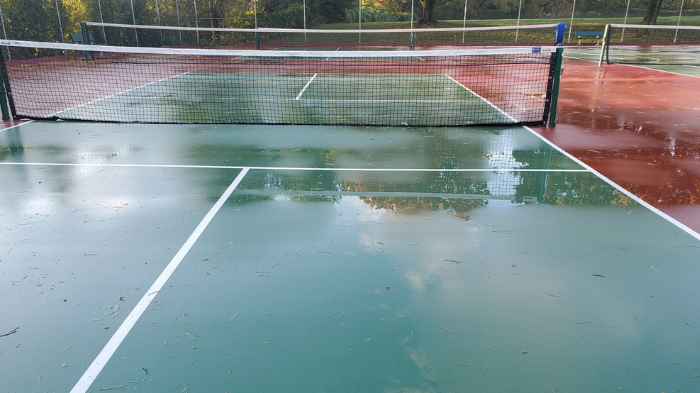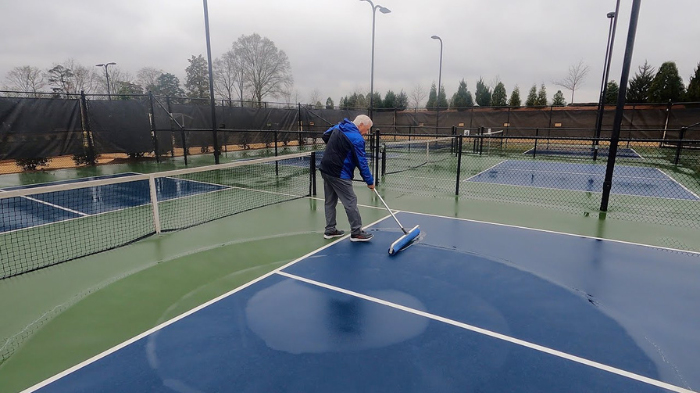Whether you are an experienced pickleball player or a beginner, a common question that may arise in your mind is, “Can I play pickleball on a wet court?”. In this blog post, we are going to answer the question, “Can you play pickleball on a wet court or not?” along with reasons why you should not play pickleball on a wet court.
Furthermore, we will share a few helpful tips in this blog to follow if you intend to play pickleball on a wet court. So read this blog, know the reasons why it is not recommended for pickleball players or beginners to play pickleball on a wet court, and follow the tips for playing pickleball on a wet court.

Is It Good to Play Pickleball on a Wet Pickleball Court?
Playing pickleball on a wet court is generally not recommended for multiple reasons. Pickleball courts are primarily designed for dry surface play, and engaging in this game on a wet pickleball court can lead to significant safety hazards and greatly diminish the overall enjoyment of the game. Here are some reasons why playing pickleball on a wet court is not recommended:
Safety Hazards: Wet courts can become slippery, increasing the likelihood of players slipping and injuring themselves. The risk of falls and injuries, such as sprains or fractures, is significantly higher on a wet surface. Players may have difficulty maintaining balance and making quick movements, which can compromise their safety.
Reduced Ball Bounce: When playing on a wet court, the surface can cause the pickleball ball to lose its bounce. The ball tends to absorb moisture from the wet surface, making it heavier and less lively. This alteration in the ball’s behavior can significantly impact the game dynamics, requiring players to adjust their shots and strategies accordingly.
Impaired Court Markings: Most pickleball courts have distinct lines and markings that define the boundaries and serve as reference points during gameplay. When a court is wet, these lines can become blurred or obscured, making it difficult for players to determine the boundaries accurately. This can lead to disputes and hinder the overall flow of the game.
Equipment Damage: Playing on a wet court can have a negative impact on the equipment used in pickleball, including paddles and balls, potentially causing damage or reduced performance. When pickleball balls become waterlogged, they tend to deform and become less responsive, leading to a decrease in shot accuracy and control. Additionally, moisture can damage wooden paddles or cause grips to become slippery, impacting the ability of pickleball players to handle their equipments effectively.
Maintenance Concerns: Continuously playing pickleball on a wet court can contribute to premature wear and tear of the playing surface. Moisture can seep into the court material, causing it to deteriorate faster and potentially requiring more frequent repairs or resurfacing. It is essential to protect the longevity and quality of the court by avoiding excessive moisture exposure. At pickleball courts, San Diego, it is strictly prohibited not to play on wet courts.
Tips for Playing Pickleball Safely on a Wet Court
It is challenging to play pickleball on a wet pickleball court because there may be risks of increased slips and falls during the game. However, with some precautions and adjustments to your gameplay, you can still enjoy the sport safely. Here are some tips for playing pickleball on a wet court:
Evaluate The Court Conditions: Before you start playing, assess the court conditions to determine if the pickleball court is safe to play. Look for standing water, slippery areas, or any hazards that could increase the risk of injury. If the court is excessively wet or unsafe, it is best to postpone your game.
Wear Appropriate Footwear: To keep traction on a wet court, it is essential to wear appropriate footwear. Optimal traction can be achieved by wearing shoes with a firm grip and non-slip soles. It is crucial to avoid shoes with smooth soles or worn-out tread patterns, as they significantly raise the risk of slipping on such surfaces.
Slow Down Your Game: Adapt your playing style to accommodate the wet court conditions. Slow down your movements and take shorter steps to maintain stability. Avoid sudden changes in direction or rapid acceleration, as it can lead to slips and falls.
Dry The Court If Possible: Before playing, you can use towels or squeegees to dry a wet pickleball court. Remove any standing water or puddles, and carefully dry wet spots on the court using towels or squeegees. It is crucial to be cautious during this process to prevent the surface from becoming dangerously slippery. Take the necessary precautions and ensure that the court is safe and suitable for playing before starting your game.

Modify Your Shots: To minimize the risk of losing balance or slipping, adjust your shots accordingly. Instead of going for powerful shots, prioritize controlled ones. Opt for a shorter swing and emphasize accuracy and placement rather than attempting to hit the ball with maximum force.
Reduce Your Slide: When moving sideways, it is necessary to minimize sliding as much as possible. Keep your weight evenly distributed on both feet, avoiding excessive leaning to one side. Opt for taking small steps rather than sliding to ensure better stability.
Increase Your Distance: When playing on a wet court, giving yourself additional space is crucial. This helps reduce the chances of collisions or accidental slips. Increasing the distance between you and your opponent provides more time to react and adjust your movements accordingly.
Avoid Sharp Turns: Making sharp turns can be risky on a wet court. Instead, take wider turns and gradually change direction to maintain balance. To minimize sudden changes in direction, it’s helpful to plan your movements and anticipate the ball’s trajectory.
Be Mindful Of Your Surroundings: Pay attention to your surroundings and be aware of any puddles or slippery areas on the court. Communicate with your partner and opponents to avoid collisions or accidental slips. Keep an eye out for wet spots and adjust your movements accordingly.
Stay Low: Maintaining a lower center of gravity can significantly enhance your stability when playing on a wet pickleball court. By bending your knees slightly and adopting a balanced stance, you can improve control and reduce the risk of slipping or losing your footing. This posture not only helps you stay grounded, but also allows for better maneuverability and quick reactions during gameplay.
Also Read About: wrist pain pickleball And What is Major League Pickleball?
Frequently Asked Questions
While it is feasible to play pickleball on a wet court, it is generally not advisable due to safety risks and potential effects on gameplay.
Playing pickleball on a wet court can increase the chances of slipping and falling, leading to injuries. Wet surfaces reduce traction and make sudden movements more unpredictable.
It is best to avoid playing pickleball on a wet court altogether. However, players can consider using proper footwear with good grip, adjusting their movements to reduce sliding, and maintaining open communication with other players to ensure safety.
When the pickleball court is wet, players have various alternative options to consider. They can choose to play at indoor pickleball courts, actively seek out dry outdoor courts, or postpone the game until the court has dried up. These alternative choices offer safer and more suitable conditions for enjoying a game of pickleball.
Playing pickleball on a wet court substantially impacts the game dynamics. The unpredictable bounce of the ball on a wet pickleball court presents difficulties in maintaining shot accuracy. Furthermore, the diminished traction on the wet surface hinders footwork and agility, leading to difficulties in swiftly changing directions and potentially undermining overall performance.
Conclusion
“Can You Play Pickleball On A Wet Court?” No, you must not play pickleball on a wet court because it can lead to safety hazards, reduction in bouncing of pickleball ball, damage of pickleball equipments, wear and tear of playing court surface, and impaired court markings.
If you want to play pickleball on a wet court, even if it is not recommended, follow the tips for playing pickleball on a wet pickleball court. These tips include evaluating the pickleball court conditions, wearing appropriate footwear, modifying shots, increasing distance, etc. By following the tips for playing pickleball on a wet court mentioned in this blog, you can have a satisfying pickleball experience even on a wet court.



